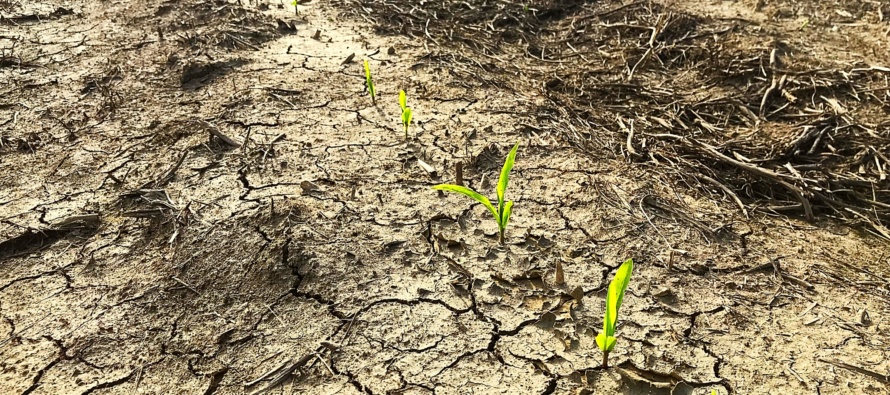How to Assess Uneven Stands and Corn Replanting Methods

Related Articles
- 2010 Soybean And Corn Variety Trial Data 3
- Flag The Technology 0
- Spring Nitrogen Fertility Suggestions for Wheat 0
Latest Tweets
Rainy weather and extended soil saturation are causing some corn stand establishment issues once again. Corn seedlings are quite vulnerable to prolonged anaerobic conditions, particularly from the initiation of germination until emergence. The duration of anaerobic conditions is generally far more important than the total amount of rainfall, because depriving seedlings of oxygen harms viability and growth. Thus, when rainfall persists over several days, particularly on fields with heavy clay soils, no raised beds, or deep-planted corn seed, problems are likely. These adverse conditions can cause seedling mortality or stunt seedling development, leading to growth disparity.
 A uniform, vigorous stand is critical to productivity because corn is grown at a relatively low plant density and has limited ability to alter its reproductive capability, compared to other crops. There is considerable research data to characterize corn response to plant density. We can generally sustain yields within 10% of optimum if plant population remains within 15-20% of the intended goal. However, corn yield potential declines more rapidly as mortality increases beyond 20%. This graphic illustrates how healthy corn responds to plant population.
A uniform, vigorous stand is critical to productivity because corn is grown at a relatively low plant density and has limited ability to alter its reproductive capability, compared to other crops. There is considerable research data to characterize corn response to plant density. We can generally sustain yields within 10% of optimum if plant population remains within 15-20% of the intended goal. However, corn yield potential declines more rapidly as mortality increases beyond 20%. This graphic illustrates how healthy corn responds to plant population.
However, we normally have other factors that jeopardize plant health when problems occur. Thus, the outcome is often more harmful than expected. Fortunately, we conducted research sponsored by the Mississippi Corn Promotion Board at Mississippi State University to address these complicated scenarios. Our findings show corn emergence uniformity is also very important and needs to be accounted for when assessing marginal stands. These late-emerging plants lag in growth throughout the season creating lopsided competition for valuable resources, which reduces crop yield potential. While these “late-emerging” plants do mimic weed competition in some ways, they do produce grain, so they have more value than that analogy. However, corn yields will be collectively reduced, dependent primarily upon the degree of growth disparity present in the stand.
To assess potential outcomes, we must use a consistent method to characterize the disparity. You have likely heard of using a flag test to time emergence, but this method does not account for temperature affecting corn growth, and thus has marginal practical value for a consultant. Our research showed the best field method to characterize growth disparity is to measure leaf stage differences using the “Droopy” leaf staging method commonly used by hail insurance adjusters. This method is based upon the number of leaves mostly emerged, where the top leaf is at least 50% emerged and/or the leaf tip is pointing down or drooping below horizontal. This method is different than the more universal “Leaf Collar” growth staging method, which is based upon fully emerged corn leaves having a visible leaf collar.
 Corn yield reduction resulting from variable emergence is determined primarily by the degree of growth disparity present. Various patterns of emergence disparity did not influence productivity differently. However, disparity present in one-third of the stand or more may reduce corn yield 10% when disparity is at least two leaf stages. Corn yield reduction increased to 18% for disparity of three leaf stages. In summary, growth disparity can reduce corn productivity similar to that associated with low plant density.
Corn yield reduction resulting from variable emergence is determined primarily by the degree of growth disparity present. Various patterns of emergence disparity did not influence productivity differently. However, disparity present in one-third of the stand or more may reduce corn yield 10% when disparity is at least two leaf stages. Corn yield reduction increased to 18% for disparity of three leaf stages. In summary, growth disparity can reduce corn productivity similar to that associated with low plant density.
If do you need to replant, it is critical to resist the urge to “fill in” or “spot plant” a partial stand. Replanting into a partial corn stand creates harsh competition between contrasting ages of plants, severely reducing yield potential. Thus, it is imperative to destroy the remaining live corn plants with either tillage or herbicides, before you replant a poor stand.






Let me tell You a sad story ! There are no comments yet, but You can be first one to comment this article.
Write a comment